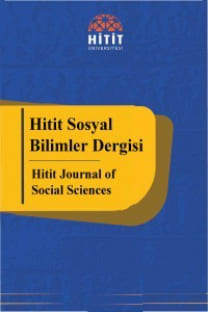KAMU YÖNETİMİNDE KURUMSALLAŞMANIN YENİDEN YAPILANDIRILMASI
Kurumsallaşma, Bireyselci Akım, Reform Çalışmaları, Yeni Kamu
-
Institutionalism, Individüalist Approach, Reform Practices, New Public,
___
- Alford, Robert R., and R. Friedland (1985), Powers of Theory: Capitalism, the State, and Democracy, Cambridge University Press.
- Bell, D. (1976), The Cultural Contradictions of Capitalism, New York: Basic Books.
- Brenner, N. (1999), “Globalisation as Reterritorialization: The Rescaling of Urban Governance in the European Union”, Urban Studies, cilt.36, S.3, ss. 431-451.
- Coşkun, B. (2005), “Türkiye’de Kamu Yönetiminde Yeniden Yapılanma Tarihsel Geçmiş ve Genel Bir Değerlendirme”, Türk İdare Dergisi, S.448, ss. 13-47.
- Denhardt, R. (2011), Theories of Public Organization, Wadsworth/Cengage Learning.
- DiMaggio, P.J. (1982), “The Structure of Organizational Fields: An Analytical Approach and Policy Implications”, Paper prepared for SUNY-Albany Conference on Organizational Theory and Public Policy, April 1st and 2nd.
- DiMaggio, P.J., and W.W. Powell (1983), “Iron Cage Revisited: Institutional Isomorphism and Collective Rationality in Organizational Fields”, American Sociology Review, S.48, ss. 147-160.
- DiMaggio, P.J., and W.W. Powell (1991), “Introduction”, In W.W. Powell and P.J. DiMaggio (Eds) The New Institutionalism in Organizational Analysis, ss. 1-38, Chicago: University of Chicago Press.
- Güler, B.A. (2003), “Devlette Reform”, Mimarlık Dergisi, Mart, ss. 1-26.
- Heath, J. (2005), “Methodological Individualism”, The Stanford Encyclopedia of Philosophy, Summer Edition.
- Henderson, A.M., and T. Parsons (1948), Max Weber: The Theory of Social and Economic Organizations, New York: Oxford University Press.
- Keating, M (1995), “Size, Efficiency and Democracy: Consolidation, Fragmentation and Public Choice”, In D. Judge, G. Stoker, and H. Wolman (Eds) Theories of Urban Politics, SAGE Publications.
- Kleinberg, B. (1994), Urban America in Transformation: Perspectives on Urban Policy and Development, Sage Publications.
- Lowndes, V. (2009), “New Institutionalism and Urban Politics”, In J. Davies, and D. Imbroscio (Eds) Theories of Urban Politics, London: SAGE Publications.
- March, J.G., and J.P. Olsen (1976) Ambiguity and Choice in Organizations, Bergen: Universitetsforlaget.
- Meyer, J., and B. Rowan (1977), “Institutionalized Organizations: Formal Structure as Myth and Ceremony”, American Journal of Sociology, S. 83, ss. 340-363.
- Mıhçıoğlu, C. (1986), Bir Yönetim Deneyi: İdari Danışma Merkezi Kırtasiyecilikle Savaş, Ankara Üniversitesi Basın-Yayın Yüksekokulu Yayınları: 7.
- Olson, M (1965), The Logic of Collective Action: Public Goods and the Theory of Groups, Harvard University Press.
- Osborne, D. and T. Gaebler (1992), Reinventing Government: How the Entrepreneurial Spirit is Transforming the Public Sector, Addison-Wesley Publishing Company.
- Özdemir, S. (2007), Küreselleşme Sürecinde Refah Devleti, İstanbul Ticaret Odası Yayınları.
- Özelleştirme İdaresi Başkanlığı (2014), Türkiye’de Özelleştirme Uygulamaları Bülteni, ÖİB Basın ve Halkla İlişkiler Daire Başkanlığı.
- Savitch, H. and R.K. Vogel (2004), “Suburbs without a City: Power and City-County Consolidation”, Urban Affairs Review, S. 39, ss. 758-790.
- Stone, D. (2012), Policy Paradox: The Art of Political Decision Making, W.W. Norton & Company.
- Şat, N. (2009), “Yeni Kamu Yönetimi Anlayışı: Weber Bürokrasisinin Sonu Mu?”, Hitit Üniversitesi Sosyal Bilimler Dergisi, cilt.2, S.1, ss. 93-108.
- Tibeout, C. (1956), “A Pure Theory of Local Expenditures, Journal of Political Economy”, The University of Chicago Press, S. 64, ss. 416-424.
- Peterson, P. (1981), City Limits, Chicago: University of Chicago Press.
- Weber, M. (1968), Economy and Society: An Outline of Interpretive Sociology. Three Volumes, New York: Bedminster.
- Weick, Karl E. (1976), “Educational Organizations as Loosely Coupled Systems”, Administrative Science Quarterly, S.21, ss. 1-19.
- Yayın Aralığı: Yılda 2 Sayı
- Başlangıç: 2008
- Yayıncı: Hitit Üniversitesi
SPORDA TOPARLANMA STRATEJİLERİ
Hayrettin GÜMÜŞDAĞ, Halit EGESOY, Emrah CERİT
TÜRKİYE'DE DEVLET KİMLİĞİ VE DIŞ POLİTİKA
ANTİK DÖNEMDE ORBİTAL SELÜLİT: CİDE/TÜRBETEPE TÜMÜLÜSÜ’NDEN BİR ÖRNEK
OSMAN ÇEVİKSOY’UN HİKÂYELERİNDE ALMANYA’DAKİ BİRİNCİ VE İKİNCİ KUŞAK GÖÇMEN TÜRKLER
TÜRKİYE'DE DEVLET KİMLİĞİ VE DIŞ POLİTİKA
DİPLOMAT BİR YAZARIN KALEMİNDEN: İZMİRLİ
IV. ULUSLARARASI TÜRK DÜNYASI EKONOMİ FORUMU DÜZENLENDİ
POLİSLİĞİN KRONİK HASTALIĞI: KİNİZM
PERFORMANS ESASLI BÜTÇE: ABD, İNGİLTERE ve TÜRKİYE ÖRNEKLERİ
